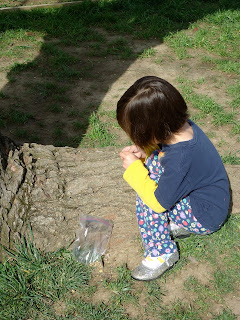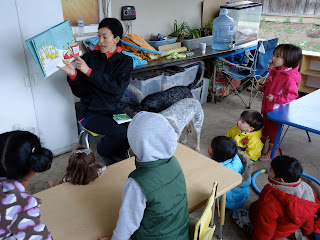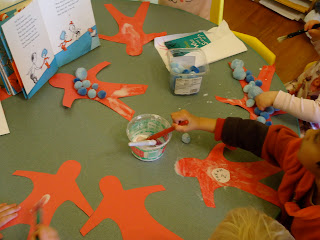Children get many different messages from television, beyond the "lessons" presented in the programming itself. (Remember how the GI Joe had a safety lesson at the end of each episode? Yet all I remember is the violence and action in the show.)
Television exposes children to imagery and information that children must process in order to fit into their understanding of life. Dramatic play (pretend play) serves as an outlet and safe context through which the children make sense of TV input. It's hard for children to differentiate real and imaginary, and what they see on television might as well be seen right before their eyes. A child's brain responds to the events similarly regardless of whether it's pretend or real.
At Beansprouts, it started with Superheroes. I knew right away who were the TV watchers when a child brought an item that displayed popular superhero characters. The children who knew the superhero scripts swarmed around the child, pointing out the characters, and subsequently engaging in dramatic play that involved angry facial expressions, loud yelling, donning invisible weaponry in what I can only imagine is the way swords and guns are held on the popular TV shows.
And now the battle is on between me and the television. While children bring into their preschool lives scripts and ideas from inappropriate television programming made with no other purpose in mind than selling ad time, I feel the constant pressure to offer up an alternative reality for them. However, I'm a lowly preschool teacher with limited resources. Mattel, Disney, and the big TV market researchers have millions of dollars to spend to try to figure out just how to market to children in a way that will not only captivate them but hold them prisoner, along with their parents.
Did you know that television marketing for children actually encourages children to nag their parents? Read this brief article on "
Pester Power"...it's disturbing. Children are easy targets for marketing because they lack the critical thinking that adults have. And let's face it, as a college graduate with critical thinking skills, I
still succumb to the pressures of marketing.
The problem doesn't end with the child who watches graphic television and acts it out. In fact, the main problem (according to Stephanie) arises when its infectious messages permeate everyone else's play. Social psychology is a force to be reckoned with, and when a child sees another playing violent superhero games, it looks fun and they want to play the game, too. Scripts are passed from one child to another ("Let's shoot the bad guy!") and soon the "us vs. them" mentality is on.
The brain is wired for exclusionary behavior. Perhaps this capacity for discriminatory thinking helped our hunter-gatherer ancestors decipher dangerous situations from safe ones. Who knows. At any rate, it's a human cognitive trait that guarantees that without intervention, children will separate themselves according to the most obvious, visible characteristic (
often race because it's the most visual difference). "Us" versus "the bad guys", the boys vs. the girls, the cool kids versus the uncools...it's inevitable but also our job to make sure to keep it's impact on the child's thinking at bay.
Assumptions made in the superhero script:
- Guns solve problems
- Bad guys are inherently bad rather than good people who make bad choices
- Pretty girls need handsome, rich, or aggressive boys to solve their problems for them
- Good guys are strong white males
- Bad guys are dark complexioned men with foreign accents
- Bad guys always have a stupid bumbling sidekick (okay, this actually might be true)
- You can beat someone up or kill them and then walk away, rather than deal with the gruesome reality of what that actually looks like (ambulance, worried family members, police reports and accountability)
Stay tuned for more on this topic and to see what unfolds as I explore the notion of The Bad Guy (with myself and with the children). It's a losing battle to try to stop children from acting out the "us versus the Bad Guy" mentality. What I'd like to do with it is take it in a new direction...where we give the kids an alternative to the ending of the story that goes "and they shot the bad guy and saved the day. The End."
*Stephanie*






























































